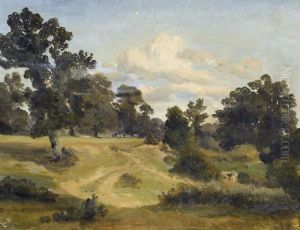Maximilian August Zimmermann Paintings
Maximilian August Zimmermann was a German landscape painter born on October 13, 1811, in Zittau, Saxony. He was primarily known for his romantic landscape paintings, which often featured German and Austrian scenery. Zimmermann's work is characterized by its attention to detail, use of light, and a penchant for capturing the mood of the natural landscapes he depicted.
Zimmermann embarked on his artistic career by studying at the Academy of Fine Arts in Dresden, an institution renowned for its emphasis on traditional painting techniques and classical aesthetics. It was here that he honed his skills and developed a deep appreciation for the natural world, which would become the central theme of his artistic work.
Throughout his career, Zimmermann traveled extensively across Europe, drawing inspiration from various landscapes and environments. His paintings often reflected the grandeur of the Alps, the tranquility of forest scenes, and the pastoral beauty of rural life. Zimmermann's approach to landscape painting was influenced by the works of his predecessors in the Romantic movement, such as Caspar David Friedrich, whose works also displayed a deep reverence for nature.
Despite being less well-known than some of his contemporaries, Zimmermann's paintings were appreciated for their beauty and composition, and he was able to establish a modest but dedicated following during his lifetime. He exhibited his works at various art exhibitions and was a member of the art communities in the regions where he lived and worked.
Maximilian August Zimmermann passed away on May 5, 1878, in Munich. His artistic legacy, while not as widely recognized as some of his peers, remains an important part of the Romantic tradition in German art. Today, his paintings can be found in several art museums and private collections, where they continue to be admired for their exquisite representation of nature's splendor.

